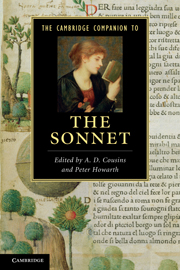Book contents
- Frontmatter
- Introduction
- 1 Contemporary poets and the sonnet
- 2 The sonnet and the lyric mode
- 3 The sonnet, subjectivity and gender
- 4 The English sonnet in manuscript, print and mass media
- 5 European beginnings and transmissions
- 6 Desire, discontent, parody
- 7 Shakespeare’s Sonnets
- 8 Sacred desire, forms of belief
- 9 Survival and change: the sonnet from Milton to the Romantics
- 10 The Romantic sonnet
- 11 The Victorian sonnet
- 12 The modern sonnet
- 13 The contemporary sonnet
- Further reading
- Index
Introduction
Published online by Cambridge University Press: 28 May 2011
- Frontmatter
- Introduction
- 1 Contemporary poets and the sonnet
- 2 The sonnet and the lyric mode
- 3 The sonnet, subjectivity and gender
- 4 The English sonnet in manuscript, print and mass media
- 5 European beginnings and transmissions
- 6 Desire, discontent, parody
- 7 Shakespeare’s Sonnets
- 8 Sacred desire, forms of belief
- 9 Survival and change: the sonnet from Milton to the Romantics
- 10 The Romantic sonnet
- 11 The Victorian sonnet
- 12 The modern sonnet
- 13 The contemporary sonnet
- Further reading
- Index
Summary
A lawyer invented the sonnet. Sometime in the mid 1230s, at the Sicilian court of Emperor Frederick II, Giacomo da Lentini created a lyric form that has now travelled a long way from its small, but cosmopolitan, place of origin. It has since been written in dozens of languages and dialects, on vellum, parchment, paper, screen and Valentine’s card. It has circulated between lovers and would-be lovers, among coteries, as celebrity confession, religious meditation and appeal to the public conscience. It has been held up as poetry’s epitome and poetry’s enemy; it has been the language of lords and the reply for bondsmen, a foreign import and a cultural talisman, and has proved itself capable of joint ventures with everything from the novel to the haiku. It has been fashionable, neglected, and fashionable again for reasons that would have been incomprehensible to the people who first made it fashionable. The sonnet has become the international and transcultural form it is today, in other words, not simply because it had the good fortune to hitch-hike round the world on the back of English imperial power a few hundred years later, but because that lawyer’s invention was very good at being adapted, adopted, and talking back.
- Type
- Chapter
- Information
- The Cambridge Companion to the Sonnet , pp. 1 - 5Publisher: Cambridge University PressPrint publication year: 2011



